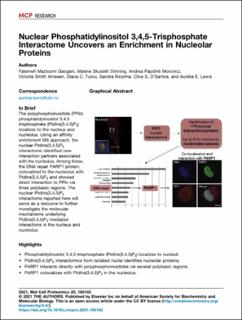| dc.description.abstract | Polyphosphoinositides (PPIns) play essential roles as lipid signaling molecules, and many of their functions have been elucidated in the cytoplasm. However, PPIns are also intranuclear where they contribute to chromatin remodeling, transcription, and mRNA splicing. The PPIn, phosphatidylinositol 3,4,5-trisphosphate (PtdIns(3,4,5)P3), has been mapped to the nucleus and nucleoli, but its role remains unclear in this subcellular compartment. To gain further insights into the nuclear functions of PtdIns(3,4,5)P3, we applied a previously developed quantitative MS-based approach to identify the targets of PtdIns(3,4,5)P3 from isolated nuclei. We identified 179 potential PtdIns(3,4,5)P3-interacting partners, and gene ontology analysis for the biological functions of this dataset revealed an enrichment in RNA processing/splicing, cytokinesis, protein folding, and DNA repair. Interestingly, about half of these interactors were common to nucleolar protein datasets, some of which had dual functions in rRNA processes and DNA repair, including poly(ADP-ribose) polymerase 1 (PARP1, now referred as ADP-ribosyltransferase 1). PARP1 was found to interact directly with PPIn via three polybasic regions in the DNA-binding domain and the linker located N-terminal of the catalytic region. PARP1 was shown to bind to PtdIns(3,4,5)P3 as well as phosphatidylinositol 3,4-bisphosphate in vitro and to colocalize with PtdIns(3,4,5)P3 in the nucleolus and with phosphatidylinositol 3,4-bisphosphate in nucleoplasmic foci. In conclusion, the PtdIns(3,4,5)P3 interactome reported here will serve as a resource to further investigate the molecular mechanisms underlying PtdIns(3,4,5)P3-mediated interactions in the nucleus and nucleolus. | en_US |

